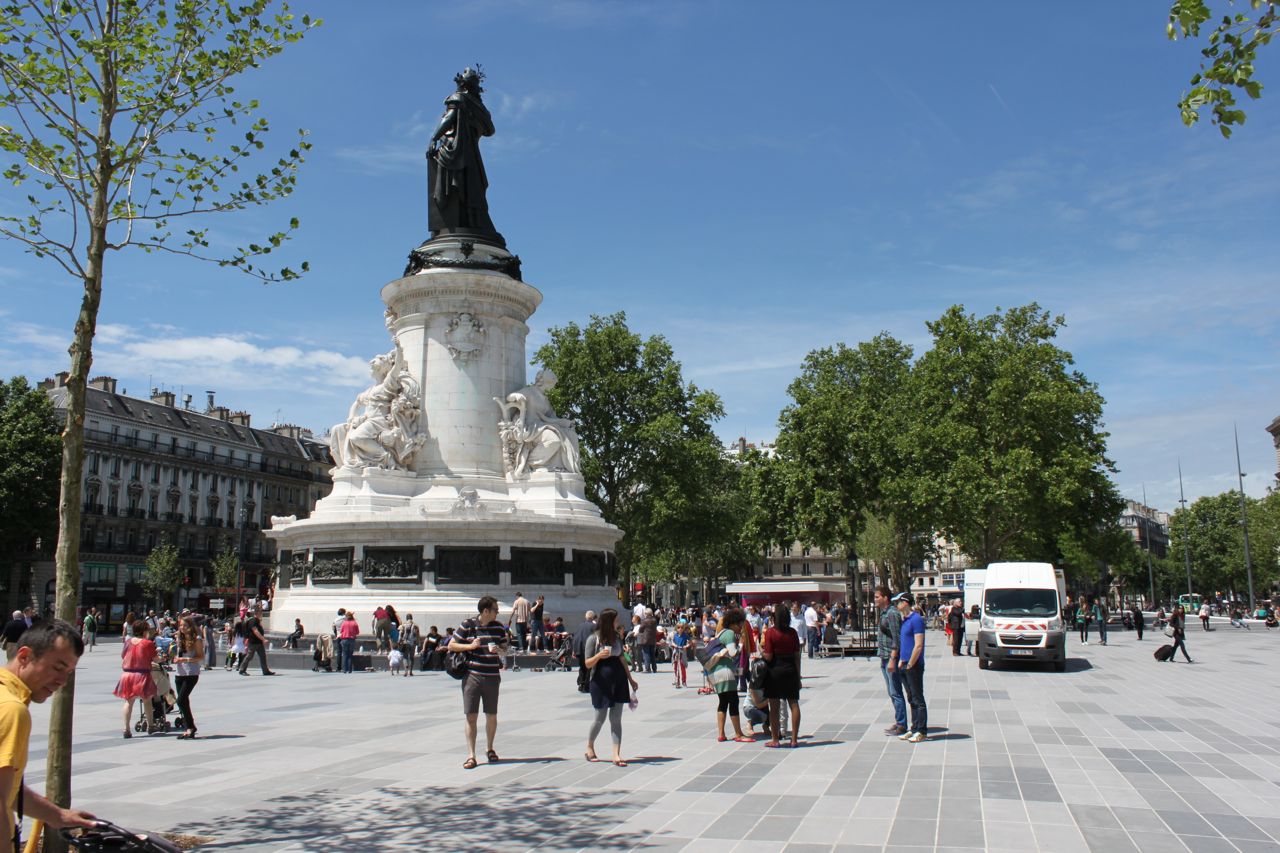I described in a previous post how the place de la République has been a 150-year urban design headache. So when I visited the space on the day of its opening, after nearly two years of construction, what I wanted to know was if the urban design conundrum had finally been solved.
The place de la République, which used to be an enormous traffic circle, is part of the City of Paris’s drive to increase the space dedicated to pedestrians and bicycles and decrease the space dedicated to the automobile.
Automobile traffic is now restricted to three sides of the square, a change that required a new traffic pattern, which was put in place last year (see my post on the subject). As of today’s opening, two thirds of the place de la République is dedicated to pedestrians. Bicycles, buses and taxis are still allowed to cross along the north-east side of the square.

The new place de la République was designed by the up-and-coming Parisian firm TVK, who first gained attention in the field by their work on Paris’s périphérique highway and have recently been invited to join the roster of architects and urban planners advising the government on Grand Paris.
There was therefore little doubt that the design of the square would be elegant, spare, and very contemporary, and it is all these things. There is a visible repugnance of clutter, a preference for the understated. The urban furniture is well ordred, as are the trees, who have made an appearance on the square en masse (155 of them). The spaces dedicated to non-motorized forms of transportation – plentiful on a sunny Sunday afternoon – functioned very well. From a historical perspective, a feature of the design I particularly like is the steps along the north-east side, emphasizing the declivity of the site that was hitherto very difficult to discern, and that harks directly back to this space’s use as a rempart centuries ago.

What I wanted to know, however, was whether the square would function as a gathering space for people. A giant void, even if elegantly designed, would still only be a giant void.
People do indeed seem to have very quickly taken to the new square. The designers have exploited opportunities to create ledges and other spots that people can use. The public benches big and comfortable, easily accommodating different sorts of users. The base of the statue at the center of the square has itself been designed as a gathering place. And several people found spots they felt perfectly suited to an afternoon nap in the sun.



The place de la République was of course full of people on the opening day, but the question for the longer term is if people will have enough things to come and do here for the square to avoid sinking back into its former emptiness. For the moment, it is hard to answer that question.
But on this opening day the place de la République was lively indeed. A big play area on one side of the square offered dozens of refreshingly simple and uncommercial games, free of charge. A bit further, a big oak platform was being used for games by a slightly older crowd, but apparently in the future it will be more for shows and concerts. At the other end of the square, an area of water play was very popular. Next to it stood the carcass of a café that will not be open for another month.



But, as I strolled the newly opened space, it became clear to me that something much more important was happening on the place de la République today than people simply enjoying a nice day out.
Parisians were taking back a place that, for decades and decades, had been in practice off-limits to them. They were discovering a new, modern, very alluring urban space, that many of them found reflected their values. In the face of such enthusiasm, discovery, and sense of pride, I could not help thinking of the day in 1861 when the avenue Malesherbes and parc Monceau were first opened to a similarly curious and enthused Parisian crowd.
The City of Paris had anticipated this mood in the slogan they chose for the opening: “The square is yours.” The organizers further catalyzed the sentiment by distributing stickers for people to post comments on a dedicated wall. By early afternoon the wall had become an outpouring of enthusiasm and affection for the new design of the square. One commentator, visibly pleased with how this project has turned out, suggested the municipality urgently give the same treatment to the place de la Bastille.

Readers of Paris Reborn will know that one thing I think the Second Empire got right was large scale popular celebrations of the new projects for the City that gave collective meaning to the political enterprise of transforming the city.
This inauguration had none of the pomp and formality of the Second Empire; instead it was relaxed and participative. But it was nevertheless, like the great inaugurations of the mid-nineteenth century, a chance to celebrate a collective vision for Paris. Perhaps Paris’s future is again becoming something we can believe in.




3 thoughts on “The Unveiling of the New Place de la République”
Comments are closed.